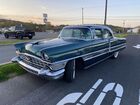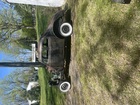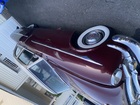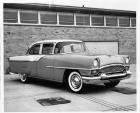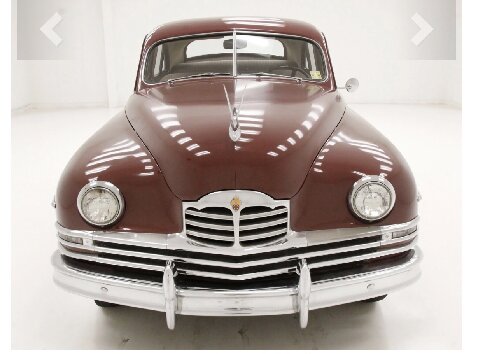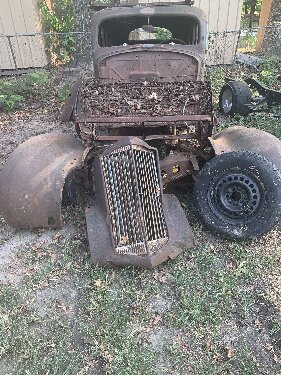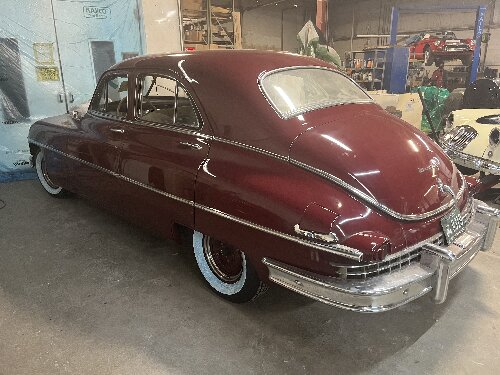|
Re: 1941-47 senior tail lights according to Hoyle and Packard
|
||||
|---|---|---|---|---|
|
Home away from home
|
Thank you, gentlemen!
Posted on: 2012/7/29 15:07
|
|||
|
||||
|
1941-47 senior tail lights according to Hoyle and Packard
|
||||
|---|---|---|---|---|
|
Home away from home
|
Asking this of any longtime senior owners who really know what Packard, the industry, Zeus, Minerva, Mr. and Mrs. America and all the ships at sea preferred, assuming there was a "right" way.
On both old body style 1941-42 One-Sixty/One Eighty, and their 1942-47 Clipper counterparts, all these having two bulbs in each tail light housing, which went on top, the single element turn signal bulb, or the dual-filament tail and brake light bulb? Please, only respond if you know what Packard/the industry preferred, not however your bulbs happen to be plugged in. Sure now, 'tis a wee matter, in the scheme of things. But our fine cars are a collection of details. Thanks.
Posted on: 2012/7/28 21:19
|
|||
|
||||
|
Re: Help with planning to bring 1924 back to life
|
||||
|---|---|---|---|---|
|
Home away from home
|
Hello, Seth. I lived in Charlotte aeons ago (Myers Park). Lovely place. The attachment above Andy and Owen shared is good, but i'd add checking the torque on the manifold nuts as well as cylinder head. In fact, both were considered part of a complete tune up in the '20s, '30s, '40s, early '50s.
WD-40 is not a lubricant. It's fine stuff, and can often be used to "lead" a trail of oil into a fine cavity. It was developed long ago to preserve machinery parts, including IBM typewriter components in storage. Kerosene is also good. In fact, many farmers routinely wipe their equipment with kerosene in the fall before putting it away. The kerosene leaves a protective film. These gents don't clown around. Tractors, combines are expensive. But before starting your engine for the first time in four years, after you to all the above in the adviso Andy & Owen shared, remove the spark plugs. Squirt some thin motor oil into each plug hole. Try to angle the squirt can so you get as much oil as possible into each cylinder, not just puddling atop the valves, a problem with the L-head layout. Don't get carried away, but make sure you get enough oil in there to do some good, protect the cylinder walls. Now, with the plugs out to reduce strain on the starter, crank the engine a bit to distribute the oil. You may want to squeeze the corner of a clean rag into each plug hole to keep oil from coming out, making a mess. Reinsert the spark plugs, making sure your plugs have copper, not cheap aluminum gaskets. Tighten them just enough, according to your shop manual. Make certain your radiator's full, all the other things on the aforementioned checklist. Next, assuming no electric fuel pump, prime the carburetor with a little gasoline, maybe a teaspoon or so. Now start the engine. You'll make some smoke, so do this when your neighbors aren't watching. Assuming your car was in good repair before its long slumber, you should be fine. You may emit smoke from the tailpipe for a few blocks, if you don't run in place a few minutes. Meanwhile, any collector or vintage race car, boat or ag engine, should have a preoiler. I recommend www.masterlube.net Tell Kerry McCracken a black '47 Super Clipper in Walnut Creek, CA sent you. According to McDonnell-Douglas, Continental aircraft, the SAE, 80-90% of all engine wear occurs during the first moments of start up. Beware miracle elixirs that "cling" to cylinder walls and bearing surfaces. I never, ever start my engine until there's full oil pressure coursing through all its galleys. Don't let the downhome contingent tell you your starter provides "enough" oil pressure. Not unless you strain the hell out of it by cranking it for a couple minutes. Treating your starter motor like this every time you want to start a seldom driven collector/race car, boat, ag equipment decreases starter motor life. If you add a preoiler, and Kerry has a quick disconnect coupling so one MasterLube device can preoil several cars, you'll never annoy your neighbors again, nor give our swell pastime a bad rep, while eliminating most engine wear.
Posted on: 2012/7/28 20:56
|
|||
|
||||
|
Re: Madness plain and simple
|
||||
|---|---|---|---|---|
|
Home away from home
|
For many fiscal, legal, ethical, moral reasons, like Victor Hugo, Robert Louis Stevenson, Mark Twain, i oppose
capital punishment. Except for the clown who desecrated this car. Anyone so bereft of vision, taste, doesn't deserve to live. Give me his address. I'll do it.
Posted on: 2012/7/27 15:49
|
|||
|
||||
|
Re: '48 '49 '50 Light Bulbs
|
||||
|---|---|---|---|---|
|
Home away from home
|
BK above's right. Light bulbs are the least of our worries. My local NAPA outlet has always been able to help, and that includes ignition parts, for my '47 Super,
and other Packards before that.
Posted on: 2012/7/26 18:15
|
|||
|
||||
|
Re: Packard Twelve "blue dot" tail lights
|
||||
|---|---|---|---|---|
|
Home away from home
|
Thank you, OD, and thank you, West. Thank you, gentlemen.
Now, what i've found thus far, is the below, via www.taillightking.com I'm wondering whether (see below, and i hope it's clear enough, otherwise, click on the website above if the catalogue photos don't show up) SSBD10 "glass, blue, smooth" or SSBD24 "glass, blue, prism" more closely approximates the Packard Twelve above. I don't think it's the pictured thick-bezeled "Their." Or is it? I'd like to get this right, or close as possible, short of butchering a 1932-34 Twelve tail light lense, which i wouldn't do in a thousand years! Meanwhile, of all the supercars at the Chicago World's Fair, the Packard Twelve Car of the Dome was the most popular, drew the biggest crowds, which says volumes since it was up against the black Cadillac V-16 aero coupe, Pierce-Arrow Silver Arrow, and Duesenberg Twenty Grand. Many thanks for any exacting insight: Glass Dots of all colors Note: Click on a thumbnail picture to see a larger view!! 06/20/2012 09:24 PM I have 2 qualities of glass dots. The 8 tab ones are US made with glass dots and the bezel is stainless steel. The 4 tab ones are made in China with glass dots and the bezel is chrome plated steel. Made in China Prism Glass Dots Part # Year Description Picture Price A5010 All Glass Prism Blue Dot and Chrome Ring - NICE - Outside dia. of bezel is 1 1/16", Hole size required is 15/16", Installation Instructions (In Stock) $10 pr. A5010-5 All Glass Prism Red Dot and Chrome Ring - NICE - Outside dia. of bezel is 1 1/16", Hole size required is 15/16"Installation Instructions (In Stock) $10 pr. A5010Y All Glass Prism Yellow/Amber Dot and Chrome Ring - Nice - Outside dia. of bezel is 1 1/16", Hole size required is 15/16"Installation Instructions (In Stock) $10 pr. A5010-7 All Gold Plated Ring - for blue, Red & Amber dots - Outside dia. of bezel is 1 1/16", Hole size required is 15/16"Installation Instructions (In Stock) $5 pr. A5010-8 All Glass Prism Blue Dot and Gold Plated Ring - NICE - Outside dia. of bezel is 1 1/16", Hole size required is 15/16"Installation Instructions (In Stock) $12 pr. A5010-10 All Glass Prism Red Dot and Gold Plated Ring - NICE - Outside dia. of bezel is 1 1/16", Hole size required is 15/16"Installation Instructions (In Stock) $12 pr. US Made Prism Glass Dots with Stainless Bezel SSBD24 All Glass BLUE Prism Dot and Stainless Ring - NICE - Outside dia. of bezel is 1", Hole size required is 15/16"Installation Instructions (In Stock) $10 ea or $15 pr. SSRD24 All Glass RED Prism Dot and Stainless Ring - NICE - Outside dia. of bezel is 1", Hole size required is 15/16"Installation Instructions (In Stock) $10 ea or $15 pr. SSAD24 All Glass AMBER Prism Dot and Stainless Ring - NICE - Outside dia. of bezel is 1", Hole size required is 15/16"Installation Instructions (In Stock) $10 ea or $15 pr. SSGD24 All Glass GREEN Prism Dot and Stainless Ring - NICE - Outside dia. of bezel is 1", Hole size required is 15/16"Installation Instructions (Out of stock) $10 ea or $15 pr. Sold Out SSYD24 All Glass YELLOW Prism Dot and Stainless Ring - NICE - Outside dia. of bezel is 1", Hole size required is 15/16"Installation Instructions (In Stock) $10 ea or $15 pr. SSCD24 All Glass CLEAR Prism Dot and Stainless Ring - NICE - Outside dia. of bezel is 1", Hole size required is 15/16"Installation Instructions (In Stock) $10 ea or $15 pr. SSCRD24 All Glass RAINBOW Prism Dot and Stainless Ring - NICE - Outside dia. of bezel is 1", Hole size required is 15/16"Installation Instructions (In Stock) $10 ea or $15 pr. US Made Smooth Glass Dots with Stainless Bezel Part # Year Description Picture Price SSBD10 All Glass BLUE Smooth Dot and Stainless Ring - NICE - Outside dia. of bezel is 1", Hole size required is 15/16", Installation Instructions (In Stock) $10 ea or $15 pr. SSLBD10 All Glass LIGHT BLUE Smooth Dot and Stainless Ring - NICE - Outside dia. of bezel is 1", Hole size required is 15/16", Installation Instructions (In Stock) $10 ea or $15 pr. SSAD10 All Glass AMBER Smooth Dot and Stainless Ring - NICE - Outside dia. of bezel is 1", Hole size required is 15/16", Installation Instructions (In Stock) $10 ea or $15 pr. SSRD10 All Glass RED Smooth Dot and Stainless Ring - NICE - Outside dia. of bezel is 1", Hole size required is 15/16", Installation Instructions (In Stock) $10 ea or $15 pr. SSCD10 All Glass CLEAR Smooth Dot and Stainless Ring - NICE - Outside dia. of bezel is 1", Hole size required is 15/16", Installation Instructions (In Stock) $10 ea or $15 pr. SSCRD10 All Glass RAINBOW Smooth Dot and Stainless Ring - NICE - Outside dia. of bezel is 1", Hole size required is 15/16", Installation Instructions (In Stock) $10 ea or $15 pr. A5009 All Drill, Diamond, 15/16" for drilling in glass lens (In Stock)
Posted on: 2012/7/25 17:20
|
|||
|
||||
|
Re: Packard Twelve "blue dot" tail lights
|
||||
|---|---|---|---|---|
|
Home away from home
|
Thank you, sir. Very grainy, indistinct on my PC, but i'll look at it on my wench's or a friend's Macs, see if that helps.
So, you recall Packard's "blue dot" as being smooth and rounded, not a rounded prism, correctimo? This is bizarre. Haven't been able to Google up a lone detailed close up of the 1932-34 Packard blue dot. Not one. Know a couple fellows with 1937-39 Twelves, but that won't help. Caramba.
Posted on: 2012/7/25 3:03
|
|||
|
||||
|
Packard Twelve "blue dot" tail lights
|
||||
|---|---|---|---|---|
|
Home away from home
|
On the face of it, this'd seem to be suited for the prewar forum, but since the blue dot craze beloved by custom car/lead sledders of the late '40s, '50s might have postwar devotees here:
Would and could anyone post or direct us to a BIG, CLEAR, CLOSE UP high-definition picture of the Packard Twelve's factory blue dots? Are we correct, that "blue dots" were another Packard first? All i've found after the usual Googling is this from the Rod Journal's Forum: "Originally Posted by pasadenahotrod: Lynx-Eye Blue-dot taillamp lenses were NEVER used as factory equipment on any production vehicle. Wrong. 32-34 Packard V-12 models, Cadillac V-12 and V-16s from 32-35. There were others, mostly high-end cars with premium features appart from the rest of their car lines. It's easy enough to find as it's a matter of automotive history, not an opinion. Original Packard 12 blue center lenses are a bit pricey and visibly different than the garden variety blue dot." So, sportsfans, is the above correct? If not, would love to know what years the Twelve came so equipped; was this the only model Packard to have them; and were Packard's "blue dots" prismed or smooth? Thanks.
Posted on: 2012/7/24 16:48
|
|||
|
||||
|
Re: Why didn't Continental make an OHV V-8?
|
||||
|---|---|---|---|---|
|
Home away from home
|
Thank you, Dr. D and 58L. I'll leave it to others to launch the new thread. That way no insular souls will be "bent eight" out of shape. Some of us may enjoy a given make, but don't live in a vacuum, like to see our cars in perspective.
As mentioned elsewhere, i've several friends who are lifelong Cordites. In fact, last month i spent an afternoon on my back torquing the rod bearing caps on a friend's '36 810. The Lycoming is a good little engine, the best part of the car, other than the 1942-47 junior Clipper size. The engine's only Achilles' heel(s) are the weak aluminum cylinder heads. The car's foibles are well documented elsewhere, but i'd add a ridiculously large turning circle to them. Viewed as what it was --- the Duesenberg One Twenty --- and that it shares the identical bore/stroke with the woefully underrated Packard inline 288 of a dozen years later, the 1936-37 Cord 810-812 is interesting, being a fellow upmarket car. Aaaaaaand, we should never forget that the Packard Twelve was never intended to be East Grand Avenue's topline world beater, but a front-wheel-drive competitor of upper echelon Buicks. Packard's nine-mained, 384-ci Custom Eight was to remain the Company's topline product. Only after Cadillac launched their V-16, which was, to Packard's chagrin, a straight eight with the firing impulses halved for less crankpin loading, despite years of Clark Street crowing over the merits of their V-8, did Packard abandon the FWD idea, enlarge the V-12 and offer it as their topline alternative, knowing the public would become enamored of the more must be better mystique of "16 cylinders" and the trickle down panache bestowed on lesser GMobiles. Judas, how's that for a NY Times run-on sentence? Meanwhile, if any of y'all want to teleport our above posts to a new thread, you've my blessing. Packard didn't become an also-ran 'til Alvan Macauley left the Company in April, 1948, coincidentally just before the launch of the pug ugly bathtubs, what Tom McCahill, dean of road testers (who'd raved over the '46 junior Clipper Deluxe Eight in Mechanix Illustrated), called "a goat." Compare those sorry giant pillbugs with the hipper '48 Cadillac styling. Packard limped along with '50s hohum, which several industry observers dismissed as looking like "bigger, gaudier Fords." Even back in the '20s, when Continental and Lycoming were powering upmarket cars competing with Packard's lower lines, it helps to see the Big Picture. The key in those years is that Packard was apart and slightly above the pack, hadn't yet fallen to merely anticipating GM's next move, let alone being run by former GM production men as they were increasingly in the '40s. Some fine cars were still wrought in the '40s, the cognac from the previous dozen years of Depression and desperation, simply because Packard didn't turn into an also-ran overnight.
Posted on: 2012/7/24 16:24
|
|||
|
||||

